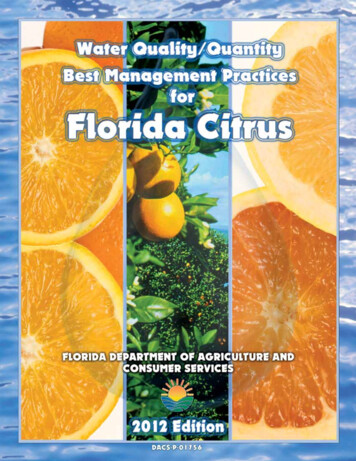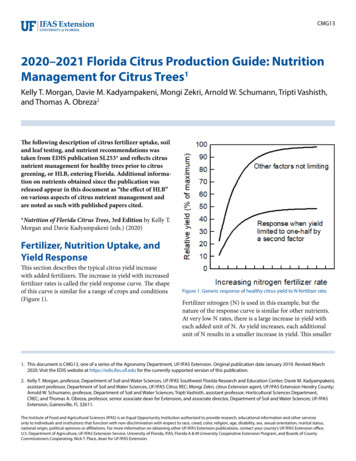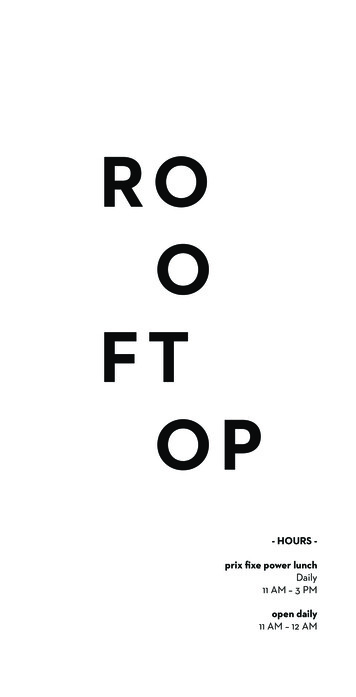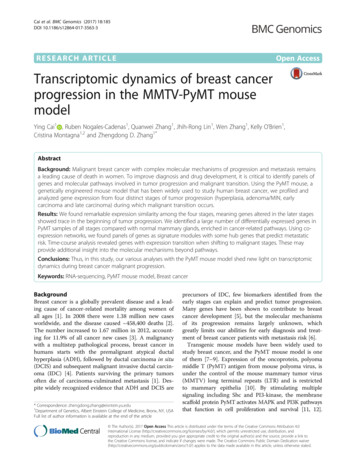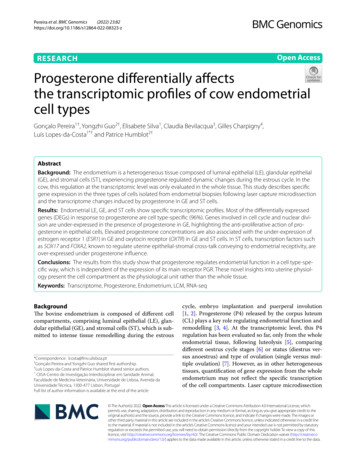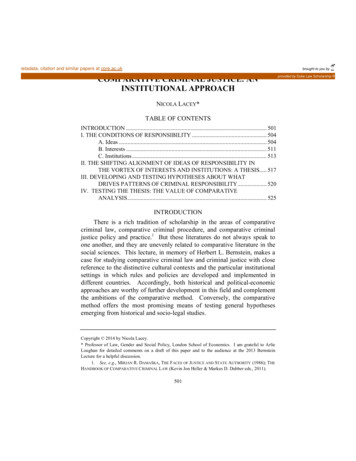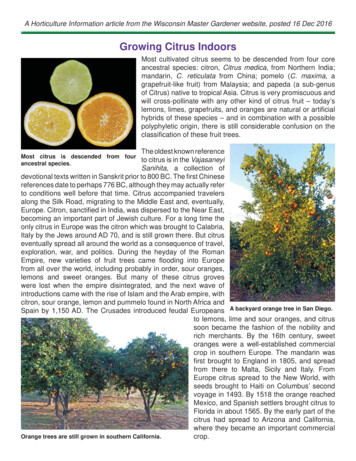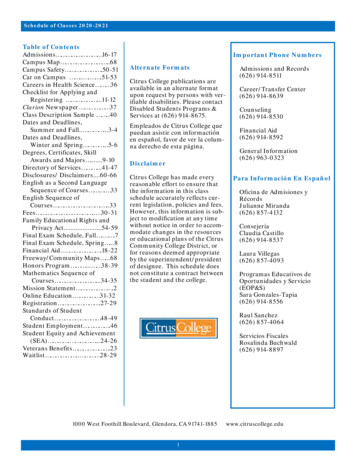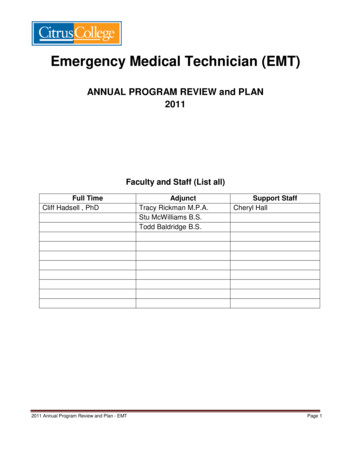
Transcription
(2022) 22:209Primo‑Capella et al. BMC Plant pen AccessRESEARCHComparative transcriptomic analysesof citrus cold‑resistant vs. sensitive rootstocksmight suggest a relevant role of ABA signalingin triggering cold scion adaptionAmparo Primo‑Capella1*, María Ángeles Forner‑Giner1, Mary‑Rus Martínez‑Cuenca1 and Javier Terol2AbstractBackground: The citrus genus comprises a number of sensitive tropical and subtropical species to cold stress, whichlimits global citrus distribution to certain latitudes and causes major economic loss. We used RNA-Seq technology toanalyze changes in the transcriptome of Valencia delta seedless orange in response to long-term cold stress graftedon two frequently used citrus rootstocks: Carrizo citrange (CAR), considered one of the most cold-tolerant accessions;C. macrophylla (MAC), a very sensitive one. Our objectives were to identify the genetic mechanism that produce thetolerant or sensitive phenotypes in citrus, as well as to gain insights of the rootstock-scion interactions that induce thecold tolerance or sensitivity in the scion.Results: Plants were kept at 1 ºC for 30 days. Samples were taken at 0, 15 and 30 days. The metabolomic analysisshowed a significant increase in the concentration of free sugars and proline, which was higher for the CAR plants.Hormone quantification in roots showed a substantially increased ABA concentration during cold exposure in theCAR roots, which was not observed in MAC. Different approaches were followed to analyze gene expression. Dur‑ing the stress treatment, the 0-15-day comparison yielded the most DEGs. The functional characterization of DEGsshowed enrichment in GO terms and KEGG pathways related to abiotic stress responses previously described in plantcold adaption. The DEGs analysis revealed that several key genes promoting cold adaption were up-regulated in theCAR plants, and those repressing it had higher expression levels in the MAC samples.Conclusions: The metabolomic and transcriptomic study herein performed indicates that the mechanisms activatedin plants shortly after cold exposure remain active in the long term. Both the hormone quantification and differentialexpression analysis suggest that ABA signaling might play a relevant role in promoting the cold hardiness or sensitive‑ness of Valencia sweet orange grafted onto Carrizo citrange or Macrophylla rootstocks, respectively. Our work providesnew insights into the mechanisms by which rootstocks modulate resistance to abiotic stress in the production varietygrafted onto them.Keywords: Cold stress, RNA-seq, Citrus macrophylla, Carrizo citrange, Rootstock, ABA signaling*Correspondence: primo amp@gva.es1Centro de Citricultura y Producción Vegetal, Instituto Valenciano deInvestigaciones Agrarias (IVIA), Valencia, SpainFull list of author information is available at the end of the articleBackgroundAs sessile organisms, plants have to adapt to adverseconditions by adopting systemic developmental andphysiological alterations that influence the plant genome,proteome and metabolome. Drought, salt and temperature stresses are major environmental factors capable of The Author(s) 2022. Open Access This article is licensed under a Creative Commons Attribution 4.0 International License, whichpermits use, sharing, adaptation, distribution and reproduction in any medium or format, as long as you give appropriate credit to theoriginal author(s) and the source, provide a link to the Creative Commons licence, and indicate if changes were made. The images orother third party material in this article are included in the article’s Creative Commons licence, unless indicated otherwise in a credit lineto the material. If material is not included in the article’s Creative Commons licence and your intended use is not permitted by statutoryregulation or exceeds the permitted use, you will need to obtain permission directly from the copyright holder. To view a copy of thislicence, visit http:// creat iveco mmons. org/ licen ses/ by/4. 0/. The Creative Commons Public Domain Dedication waiver (http:// creat iveco mmons. org/ publi cdoma in/ zero/1. 0/) applies to the data made available in this article, unless otherwise stated in a credit line to the data.
Primo‑Capella et al. BMC Plant Biology(2022) 22:209conditioning plants’ geographical distribution in nature,which limits plant productivity in agriculture and threatens food security [1].The adverse effects of these abiotic stresses are exacerbated by climate change and global warming, which havebeen predicted to result in extreme weather episodeswith intense rainfall, drought and rising temperatures,along with more frequent cold and hot waves [2–5]. Inorder to improve plant adaptation to these changingenvironmental conditions, unraveling the mechanismsthat allow plants to sense stress signals and to controlplant response to abiotic stresses is a crucial step [6].Improving plant stress resistance is critical for not onlyagricultural productivity, but also for environmentalsustainability because crops with poor stress resistanceconsume too much water and many fertilizers [7]. Thedevelopment of NGS technologies, particularly the analysis of the transcriptome with RNA-Seq, have allowed newinsights into the genetic mechanisms by which plant species adapt to their environment under diverse conditions,including exposure to abiotic stresses [8, 9].Low temperatures have a strong impact on the growthand geographical distribution of plants, and speciallyaffect tropical crops. Plant adaptation to cold stressinvolves a large number of genes with minor additiveeffects, and a clear view of the different genetic regulatory pathways regulating responses to low temperatureshas only recently been obtained in model plants [10, 11].During cold acclimation, the expression of cold-responsive (COR) genes is activated in Arabidopsis by C-repeatbinding factors, namely genes CBF1, CBF2 and CBF3.Recent studies have elucidated the molecular mechanisms by which plants activate COR genes in response tocold signals and have shown that they are also regulatedthrough CBF-independent pathways [12].CBFs are activated by MYC-like bHLH INDUCER OFCBF EXPRESSION 1 (ICE1) [13–15]. Protein ICE1’sstability and, therefore its activity, in the nucleus,increase with the post-transcriptional sumoylation bySUMO E3 ligase SIZ1. During cold stress, stabilization by SIZ1 is counteracted by both ubiquitinationand subsequent ICE1 degradation due to ring E3 ligaseHOS1 [16], which reaches the nucleus where ICE1 islocated [17, 18]. Recent reports show that ICE1 is regulated by protein kinases: MPK (mitogen-activated protein kinase), MKK (mitogen-activated protein kinasekinase) and MEKK (mitogen-activated protein kinasekinase kinase) [19, 20]. These protein kinases performdifferent functions and promote the degradation oractivation of ICE1 and, consequently, the activation orrepression of CBF genes. Besides ICE1, there are othertranscription factors (TFs) independent of CBF-regulon. In fact, CBF-regulon only represents 12% of thePage 2 of 26transcriptome response in Arabidopsis thaliana at lowtemperature. Several of these TFs bind CBF promoters: LHY and CAMTA (involved in the circadian clock);HY5 (involved in light signaling); SOC1 (involved inflower development); MYB15 (negative regulator ofCBF genes) [21, 22].Experiments run with single, double or triple cbfmutants in A. thaliana have demonstrated that not allCOR genes are affected by CBF genes, and a CBF-independent pathway is involved in the regulation of coldresponse genes. Of the 27 first-wave transcription factors, HSFC1, ZAT12, and CZF1 regulate the expressionof COR genes, but their expression is not affected in cbftriple mutants [23–26].The CBF-COR pathway functions in plants otherthan A. thaliana and CBF genes have been identifiedin a range of plant species like poplar [27], silver birch[28] and several grasses [29]. The conserved role ofCBF genes has been confirmed in other species likeapple, barley, potato and poplar because their overexpression enhances freezing tolerance, even withoutcold acclimation [23, 27, 30–33].Light quality, circadian rhythm and photoperiod areother factors that regulate cold acclimation and affect theexpression of CBF and COR genes [34]. Light is necessary for increasing freezing tolerance, and is required forthe expression of several cold-regulated genes (CORs) indifferent plant species: phytochromes activate COR15aand COR14b gene expression, and also regulate CBFtarget genes under red/far red light conditions [35]. Thecircadian clock prepares plants for cold stress, and likelyoccurs at night: at warm temperature, the transcript levels for CBF1, CBF2, and CBF3 oscillate and peak at about8 h after dawn (zeitgeber time 8; ZT8) with a trough atabout ZT20. Moreover, the cold induction of CBF1,CBF2, and CBF3 is “gated” by the clock [25]; if plants areexposed to low temperature at ZT4, the increase in theCBF1, CBF2 and CBF3 transcript levels is much moremarked than if plants are exposed to low temperature atZT16 [36].A correlation between plant winter hardiness andthe accumulation of compatible solutes has been awell-known fact for decades [37] and a growing number of studies indicate that sugars play an essential rolein plant cold tolerance [38–40]. Accumulation of soluble sugars, such as raffinose, which in Arabidopsis isinvolved in stabilizing PS II of cold-acclimated leaf cells[41], or trehalose, which confers high tolerance levelsto different abiotic stresses, including low temperaturesin rice plants [42], is associated with rapid starch degradation in chloroplasts [43], which would be inducedby abscisic acid (ABA) in response to cold and to otherabiotic stresses [44].
Primo‑Capella et al. BMC Plant Biology(2022) 22:209Cold adaption is often associated with an increasedlevel of this stress hormone, and a rising ABA levelis thought to trigger a number of cellular responsesrequired to develop freezing tolerance. Exogenous ABAapplication results in increased freezing tolerance in various higher plant species, including potato, wheat, winterrape and Arabidopsis, which suggests that ABA and coldmight function in common physiological processes andlead to the development of enhanced freezing tolerancein plants [44].Citrus is one of the most economically important fruittree crops in the world, with 148.7 million tons registeredduring the 2018/2019 season (FAO, 2021), which represents a 20.8% increase in the last 10 years and reflectsconstant annual growth. Climate is the most importantfactor for site selection in most citrus-growing regionsaround the world. Beyond certain limits, losses of treecrops or impaired fruit quality as a result of adverseweather conditions are so important that the productionof any citrus fruit can be rendered impossible or unprofitable. Freezing temperatures are some of the most limitingfactors for citrus production. Temperatures below 0ºClead to the formation of intercellular ice crystals, whichcause dehydration and damage trees [45]. The thresholdtemperature that kills young citrus shoots is -12ºC [46],but it is common knowledge that citrus species’ cold hardiness considerably varies.Rootstock/scion combinations are frequently employedin the citrus industry to improve fruit production andquality, as well as tolerance to biotic and abiotic stresses.Rootstocks are selected for root traits linked with resistance to pests and pathogens from soil, but also withseveral abiotic stresses, such as salinity, drought, floodsand cold hardiness. One example of the importance ofemploying rootstocks is to control citrus tristeza virus(CTV). This virus devastated Spanish citriculture in the1970s, but it was controlled thanks to the use of tolerantrootstocks [47].The influence of rootstocks on fruit quality-relatedtraits has a proven significant effect on mandarin fruitsize through cell size regulation [48], and also on treegrowth, yield and quality, the leaf mineral composition oflemon [49], and even on the flavonoid content of lemonjuice [50].A cold hardiness study conducted with a tetraploid Carrizo citrange rootstock showed enhanced natural chillingstress tolerance for common clementine [51]. Carrizocitrange (CAR) is a widespread rootstock resulted fromcrossing sweet orange (Citrus sinensis Osb.) and Poncirustrifoliata (L. Raf.), a citrus-relative species that can withstand temperatures of -26 C when fully cold-acclimated[52]. Several studies have shown that cold acclimationin Poncirus is mediated by the CBF regulon [53], withPage 3 of 26ICE1 acting as a central regulator of cold response [54].The PtrbHLH transcription factor, shown to confer coldtolerance to Poncirus [55], is able to promote enhancedcold tolerance when overexpressed in pummelo (Citrusgrandis) [56]. On the other hand, Citrus macrophyllaWester (MAC), which belongs to the papeda group andis the most widespread rootstock in lemon orchards, isextremely sensitive to low temperatures [57–59].In this work, we used RNA-Seq technology to studyhow Valencia sweet orange responds differently to coldstress depending on the employed rootstock. We evidence that regulatory processes produce cold acclimationand suggest a mechanism by which Carrizo, a low-temperature resistant rootstock, triggers cold acclimationresponses in the grafted scion.ResultsTotal soluble sugars, starch and proline accumulatein response to cold treatmentTotal soluble sugars and starch were quantified by spectrophotometry methods after 0, 7, 15 and 30 days ofcold treatment. A 2-fold increase in total soluble sugars(Fig. 1a) was found in the C30 plants in relation to CAR0.However, the MAC plants only showed a slight increasein total soluble sugars, and no significant difference wasfound between M0 and M30.Starch content initially increased in the CAR sampleson day 2, and was always higher in the cold-treated plantsthan in the controls (Fig. 1b). On the contrary, starchcontent slightly lowered in the MAC cold-treated plants,which had the highest concentrations on day 0 (Fig. 1b).Free proline was quantified by spectrophometric methods and on days 0, 1, 2, 4, 7, 15 and 30. As expected,proline concentration in leaves increased under cold conditions, and was generally higher in CAR than in MAC,and more significantly so at the end of the experimentwith a more than 2-fold increase (Fig. 1c).A metabolomic profile that comprised some relevantprimary metabolites was performed on days 0 and 30under cold conditions (Table 1). The levels of reducedsugars (rhamnose, trehalose, glucose) were higher on day30 in both rootstocks, although the increase in CAR wasgreater than in MAC. The increase in fructose and raffinose was marked, especially raffinose, which was 300fold in CAR and 400-fold in MAC.For protein amino acids phenylalanine and proline andnon-protein amino acid GABA quantification, no significant differences appeared at 30 days in relation to thecontrol (Table 1). However, some differences were foundfor total proline when comparing both rootstocks, whichwas 2-fold higher in CAR than in MAC at 30 days. Thisconfirmed the previous results shown above.
Primo‑Capella et al. BMC Plant Biology(2022) 22:209Page 4 of 26Fig. 1 Quantification of osmolytes in CAR and MAC leaves. Plants were grafted and grown under 1 C and control conditions for 0, 15, 30 days.a Total soluble sugars, b) starch and c) proline. Values are the means SE of three biological replicates (n 3) and three technical replicates perbiological sample. The treatment effect was tested by a multiway ANOVA. Different letters indicate significant differences (P 0.05) according to LSD
Primo‑Capella et al. BMC Plant Biology(2022) 22:209Page 5 of 26Table 1 Relative quantification of the primary metabolites in CAR and MAC leaves at 30 cold daysCarrizoC. macrophyllaCarrizoGlucoseC. macrophyllaCarrizoFructoseC. macrophyllaSaccharoseControl1.00 0.140 b1.11 0.049 ab1 0.531 b1.07 0.321 b1 0.293 b0.60 0.115 bCold1.14 0.028 ab1.36 0.161 a11.53 2.61 a8.86 1.54 a2.17 0.289 a1.92 0.088 aRaffinoseRhamnoseTrehaloseControl1 0.145 c0.62 0.085c1.00 0.032 bc0.87 0.029 c1.00 0.47 bc0.695 0.048cCold336.60 16.77 a299.55 10.27 b1.22 0.075 a1.13 0.012ab3.02 0.510 a2.33 0.561 abGABASuccinic acidFumaric acidControl1.00 0.065 c1.17 0.175c1.00 0.119 ab0.75 0.030 b1.00 0.025 b1.14 0.043 bCold3.53 0.661 b6.09 0.393 a1.95 0.469 ab2.08 0.582 a1.18 0.086 b1.60 0.178 aPalmitic acidStearic acidGlycerolControl1 0.046 b1.30 0.073a1.00 0.051 b1.29 0.069 a1.00 0.0891.21 0.059 aCold0.35 0.059 d0.65 0.039 c0.37 0.057 d0.67 0.043 c0.52 0.056 b0.68 0.052 bControl1.00 0.502 ab1.52 0.495 a1.00 0.439 b0.92 0.094 bCold0.18 0.074 c0.56 0.380 ab3.11 1.740 a2.22 1.739 abPhenylalanineProlinePlants grafted and grown at 1 C and under the control conditions. The values are the means SE of three biological replicates (n 3) and three technical replicates perbiological sample. The treatment effect tested by a multiway ANOVA, and different letters, indicate significant differences (P 0.05) according to LSDABA significantly accumulates in Carrizo rootsThe quantification of ABA and jasmonic acid (JA) hormones was carried out in roots and leaves at 0, 15 and30 days (see Methods) and significant differences werefound in the accumulation of these hormones in the different organs and rootstocks (Fig. 2).The ABA concentration in leaves lowered from 90 ng g-1 DW in M0 to 20 ng g -1 DW measured in M15 andM30, but remained constant in CAR throughout theexperiment at a concentration of around 60 ng g-1 DW(Fig. 2a). The ABA concentration in roots remained constant at low levels (10 ng g -1 DW) in MAC, but increased3-fold in CAR30. The total ABA concentration in the C30roots was strikingly higher (40 ng g-1 DW) compared toM30 (5 ng g-1 DW). The ABA concentration was 8-foldhigher in C30 (Fig. 2b).Initially the JA concentration was significantly higherin the MAC leaves (Fig. 2b), with similar levels in roots inboth rootstocks (Fig. 2d). A drop in the amount of JA wasobserved in the two analyzed organs from C15 and M15.A lower JA concentration continued in C30, while a cleargain in M30 was noted in both roots and leaves.Macrophylla plants show damage as a result of coldtreatmentWe analyzed the CAR and MAC plants to search for anyeffects caused by low temperatures after 30 days at 1 ºC.Although the Valencia shoots presented leaf damagein both rootstocks, differences were observed in youngshoots, with much severer effects on the scions graftedonto the MAC rootstock caused by cold temperatures. InMAC plants, young shoots showed brown areas and deadleaves, while in the Carrizo ones they were completelynormal (Fig. 3a).Transcriptomic study and differential gene expressionanalysisRNA‑Seq overviewRNA-Seq was carried out as described in the Methodssection. Twelve pair-end libraries were constructed andsequenced with 200 bp reads. After quality trimming,152.2 million read pairs were obtained with an average of12.7 million reads pairs per sample, which accounted for30.6 Gb of useful sequence.Reads were mapped against C. clementina 36454 transcripts, as described in the Methods section. Overall,more than 120 million reads (79%) were mapped againstthe reference transcripts, of which 77.8 million readsaligned 1 time and 42.2 million reads aligned many times,while 32.2 million reads did not map. The average number of reads per sample was 100 million reads, and theaverage number of reads mapped per gene was 274.3.The differential expression between Carrizo and Macrophyllais higher after 15D of cold treatmentThe differentially expressed genes (DEGs) between theCarrizo and Macrophylla samples were determined asdescribed in methodsIntraspecies gene expression analyses were performed by comparing samples from the same rootstockcollected after 0, 15 and 30 days of cold treatment.Samples C15 and M15 were respectively comparedto C0 and M0, and samples C30 and M30 were compared to C15 and M15. The earliest sample was taken
Primo‑Capella et al. BMC Plant Biology(2022) 22:209Page 6 of 26Fig. 2 Quantification of ABA and JA hormone in leaves and roots of the CAR and MAC plants grafted in Valencia delta seedless and grown under1 C and control conditions for 0, 15, 30 days. a ABA quantification in leaves and roots, respectively, and b) JA quantification in leaves and roots,respectively. The values are the means SE of three biological replicates (n 3) and three technical replicates per biological sampleas the control. The 15 days comparisons yielded thelargest number of DEGs for both rootstocks, with12691 for CAR and 14199 for MAC, compared to the409 and 4391 obtained in the 30 to 15 day comparison,respectively. The number of up- and down-regulatedtranscripts was similar in all the samples (Fig. 3b). TheRNA-seq results were validated by RT-PCR, which wascarried out with some relevant DEGs selected from theintra- and interspecies comparative analyses (Additional File 1).In an attempt to identify transcripts involved in thecold tolerance of CAR, interspecies comparisons ofthe samples from each rootstock collected on the samedate were made. Thus, samples C0, C15 and C30 werecompared to MAC0, M15 and M30, respectively. Thenumber of DEGs was much smaller than in the previous strategy but, as observed before, the largest number of DEGs (2423) was obtained from the 15-daysamples comparison, while the analyses of the 0- and30-day ones only showed 186 and 119 DEGs, respectively. The number of the up- and down-regulatedtranscripts was similar in all the samples (Fig. 3b).As the largest number of DEGs was obtained after15 days of cold treatment, our analyses focused onthese samples, when the response to low temperaturesseemed to peak. The identity of the DEGs obtainedby both approaches at 15 days was compared and theresults are shown in a Venn diagram (Fig. 3c), where ahigh degree of overlapping is seen.This way, 9826 common differentially expressedtranscripts were found in the intraspecific analyses(M0 and C0 vs. M15 and C15), which accounted for77% and 70% of all the obtained DEGs, respectively.Similarly, 2104 differentially expressed transcriptsfrom the interspecific comparison of samples M15 vs.C15 were also found in the intraspecific studies, andrepresents 87% of the identified DEGs. A core groupof 872 (366 up-regulated, 506 down-regulated) transcripts was found to be differentially expressed in allthree gene expression studies carried out with the15-day samples.Functional annotation of DEGs reveals the main pathwaysassociated with cold responseThe functional annotation of the differentiallyexpressed gene set obtained from the intra- (0 vs. 15 D)
Primo‑Capella et al. BMC Plant Biology(2022) 22:209Page 7 of 26Fig. 3 Phenotypic damage in the MAC and CAR plants and the RNA-seq overview. Image a) shows the MAC and CAR rootstock-grafted plants atthe end of experiment at 30 days of 1ºC. b comparison between the intraspecies and interspecies analyses. The number of genes was distributedin the up-regulated transcripts depicted in green and the down-regulated transcripts in red; c) Venn diagram representing the common DEGsbetween the intraspecies and interspecies analyses at 15 cold daysand inter- (CAR vs. MAC) comparisons was performedusing the BLAST2GO tool [60] and an a functionalenrichment analysis was performed with the FatiGOtool. GO terms with the lowest FDR scores that wereoverrepresented in at least two of the three comparisons were further analyzed (Table 2).The most significantly enriched biological functionwas response to cold, with the lowest FDR score. Otheroverrepresented functional annotations were mobilization of sugars, regulation by ABA and JA hormones, orlight and circadian cycles.We found an abundance of GO terms related to sugarmetabolic pathways: response to sucrose, oligosaccharide biosynthetic process, fructose metabolic process,glucose metabolic process, sorbitol catabolic process,etc., Some enriched terms such as the raffinose family
Primo‑Capella et al. BMC Plant Biology(2022) 22:209Page 8 of 26Table 2 The 40 most enriched GO terms for the biological process category at 15 days of cold treatmentGO IDGO NameFDRCAR-MACGO:0009409response to coldGO:0009768photosynthesis, light harvesting in photosystem IGO:0010200response to chitinGO:0006633fatty acid biosynthetic processCAR 0-15 DMAC 0-15 e to light intensity9.02E-04GO:0080167response to romophore linkage2.57E-051.39E-03GO:0055081anion homeostasis1.28E-039.26E-04GO:0009744response to sucrose2.59E-039.90E-04GO:0009312oligosaccharide biosynthetic process2.08E-032.43E-03GO:0042754negative regulation of circadian rhythmGO:0009753response to jasmonic acidGO:0009751response to salicylic 03GO:0009688abscisic acid biosynthetic process8.72E-034.88E-03GO:0006000fructose metabolic process1.41E-026.69E-03GO:0071483cellular response to blue lightGO:0000302response to reactive oxygen rotein peptidyl-prolyl isomerization2.24E-026.44E-03GO:0009816defense response to bacterium, incompatible ed signaling pathway7.50E-053.06E-02GO:0042631cellular response to water deprivationGO:0002832negative regulation of response to biotic :0019640glucuronate catabolic process to xylulose 5-phosphateGO:0010109regulation of photosynthesisGO:0010018far-red light signaling pathway3.43E-023.02E-03GO:0031348negative regulation of defense response1.44E-022.40E-02GO:0009658chloroplast organization3.37E-02GO:0009729detection of Brassinosteroids stimulus1.91E-02GO:0006116NADH oxidationGO:0080148negative regulation of response to water deprivationGO:0006006glucose metabolic -022.79E-02GO:0006062sorbitol catabolic process1.54E-023.19E-02GO:0051164L-xylitol metabolic process1.54E-023.19E-02GO:2000038regulation of stomatal complex development3.68E-021.21E-02GO:0046890regulation of lipid biosynthetic process1.74E-023.73E-02GO:0010207photosystem II assembly1.54E-024.18E-02GO:0010114response to red light3.18E-023.03E-023.21E-02GO:0015996chlorophyll catabolic processGO:0007267cell-cell signalingGO:0008643carbohydrate transportoligosaccharide biosynthetic process were present inthe interspecific comparison, others like galactose catabolic process were obtained in the C0 vs. C15 analysis(see Table 2).For light response and the circadian clock, an overrepresentation of terms like photosynthesis, sting in photosystem, protein-chromophore linkage, negative circadian rhythm regulation, far-red lightsignaling pathway and response to red light, was alsoobserved.Several enriched biological processes were relatedto the hormone signaling: response to jasmonic acid,
Primo‑Capella et al. BMC Plant Biology(2022) 22:209response to salicylic acid, ABA biosynthetic process, theauxin-activated signaling pathway, etc.Similar results were obtained when searching theKEGG database [61–63] to determine the biologicalpathways represented among the differentially expressedloci at 15 days (Additional File 2). Clearly the carbohydrate metabolism was the most represented, with 512loci involved. The reduced sugar metabolism pathways,such as those for sucrose, galactose or fructose, displayed the largest number of differentially expressed loci.Moreover, 263 genes were involved in the environmentaladaptation, specifically with plant hormone signal transduction and circadian rhythm, which play crucial rolesin the response to cold stress. Similarly, pathways forlipid metabolism with 230, biosynthesis of other secondary metabolites with 216, and amino acid metabolismwith 129 genes were well-represented in the set of DEGsat 15 days.Analysis of the differentially expressed days at 15 daysof cold treatmentA study of 13338 genes, which showed a differentialexpression after 15 days under cold conditions (M0 vs.M15, C0 vs. M15, M15 vs. C15), was carried out to identify those involved in cold response in citrus and, morespecifically, those that could be responsible for the different sensitivity to low temperatures displayed by thetwo rootstocks. As expected, a significant number ofDEGs corresponded to the genes involved in the different pathways associated with cold response, such as theCBF regulon, light and circadian clock regulation, andmetabolism of sugars.CBF regulatory pathwaySeveral genes playing relevant roles in the CBF regulatory pathway were differentially expressed during coldtreatment. They displayed different expression patterns,which are shown on the heat map in Fig. 4a.Three CBF/DRB-like genes were identified, DREB1B(LOC18049462), DREB1D (LOC18033409) and DREB2A(LOC18043521), which were overexpressed in samplesC15 and M15 vs. C0 and M0. Interestingly, both foldchange (FC) and the normalized expression levels weregenerally higher in the Carrizo samples than in the Macrophylla ones, e.g., DREB1D FC in the M0-M15 comparison was 18-fold higher than in C0-C15, and its expressionlevel was almost double.An ortholog of gene ICE1, LOC18051975, wasalso identified, which displayed a markedly reducedexpression in both samples MAC and CAR. E3 ubiquitin-protein ligase COP1, coded by citrus geneLOC18050526 responsible for ICE1 degradation, showedPage 9 of 26a steadily decreased expression in both samples CARand MAC during cold treatment. The SlZ1 citrus gene,LOC18045500, which mediates the SUMO conjugationof ICE1, was differentially expressed in intraspecies comparisons C0-C15 and M0-M15, and its expression on day15 was significantly higher in the CAR samples.The closest citrus relative to the negative regulato
of any citrus fruit can be rendered impossible or unprot - able. Freezing temperatures are some of the most limiting factors for citrus production. Temperatures below 0ºC lead to the formation of intercellular ice crystals, which cause dehydration and damage trees [45]. e threshold temperature that kills young citrus shoots is -12ºC [46],
